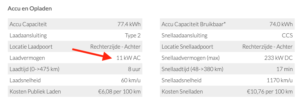1-phase – 3.7kW or 7.4kW
If you have a single-phase connection with, for example, 40A in your private setup, then only a charging point with a maximum charging capacity of either 3.7kW (230V x 16A) or 7.4kW (230V x 32A) can be installed. This is usually sufficient for overnight charging.
3-phase – 11kW or 22kW
A charging station with a three-phase connection uses 3x400V and typically has a power rating of 16A or 32A. The maximum charging capacity is then 11kW or 22kW. Charging can be up to 3 times faster than with a single-phase connection.
If your connection is 3x230V without a neutral wire, we can only connect your charging station to 1 phase, allowing a maximum charging capacity of 7.4kW at 32A.
Your vehicle must support 11kW or 22kW AC charging to achieve these speeds; some models are limited to 7.4kW or 11kW.
You can check these specifications on a helpful website here: https://ev-database.nl/
Example:

If you do not have a three-phase connection, you can usually request an extension from the network operator (Fluvius) in most cases. The costs for this may vary from municipality to municipality. For more information and to request an extension of your meter box, visit: www.fluvius.be.
